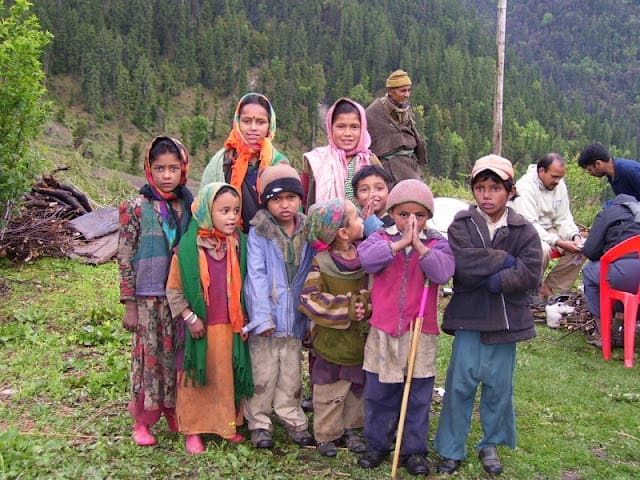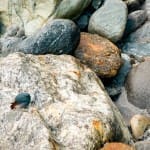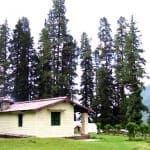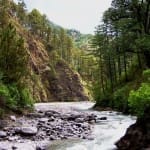In the penultimate episode of her Bedni Bugyal travelogue, Jennifer Nandi revisits the Himalayan hamlet of Kanol, tucked into a fold in the vast district of Chamoli and haunted by the ghosts of ancient forests long lost to the logger’s axe
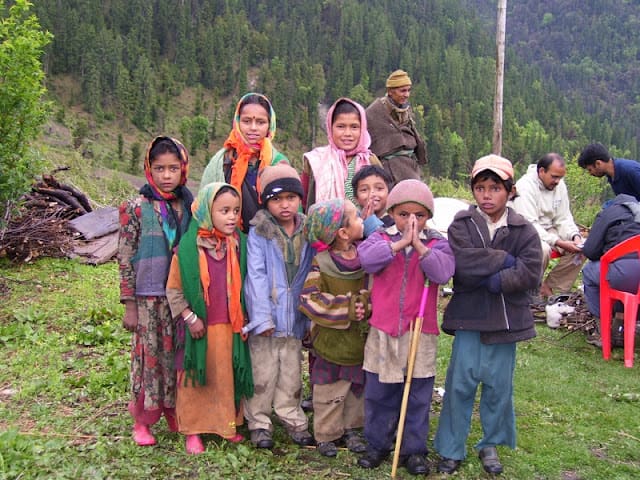 |
| Our reception committee at Kanol. Behind them, Satish and Sahastra are already warming their sodden socks by the fire |
Pastels of dawn emerge from the easel of the eastern sky. The western sky is still indigo. As we prep for departure, a bird whistles from the tops of trees that gleam with a beam of a yet-unseen sun. A still-black Blue Whistling Thrush readies itself on a rock, full of bright promise, to herald a new day. Only when shafts of light pick out its iridescence and its mantle glistens with spangled blue does it pour out its song. He’s not quite as musical as that accomplished songster, the Malabar Whistling Thrush, but his melody is pleasant, varying up and down the scale.
After photographs and fond goodbyes we set our sights uphill on the single grandest deodar tree I have yet seen. Amidst cypress and spruce, it is the only tree that flattens its crown against the sky. This morning’s trail traverses through mixed coniferous forest upwards until we reach the pass that will lead to the village of Kanol. The middle Himalaya between 6000 and 9000 ft used to be rolling, well-wooded country. Rivers and streams that dissected the hilly country sought out the clay beds between sandstones. The valleys they eroded were often miniature gorges, flanked by bluffs of sandstone. Main roads tended to follow the ridges, while minor roads dove between banks and hedges in the valleys.
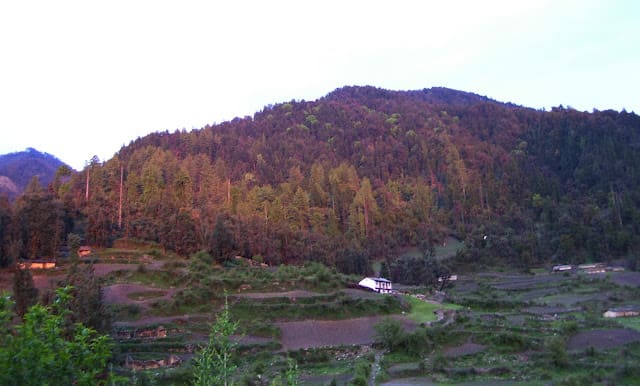 |
| On the outskirts of the village of Kanol in Chamoli district |
Old books on Garhwal speak of the gigantic size of the fine alders that lined its rivers and describe miles of noble forest of oak and rhododendron and pine. And growing luxuriantly at an elevation of over 6,000 ft were beautiful tracts of forest of a different character – Oriental Plane, Horse-Chestnut, bamboo and the wild pomegranate.
For the British, the urge to float timber down the rivers, notwithstanding the rocks and rapids, was a compelling one. It would prove to be an exceedingly profitable business. So thickly wooded were the surrounding regions in many places that, according to British foresters of yore, one single square mile would furnish a navy with timber; and the growth of a hill, all the navies in the world.
Today we comfort ourselves alternating between chasms of charred forest and heights of pure stands. The Western-crowned Warblers engage us with their spirited breeding behaviour, constantly repeating their cheerful, rapid chiwee-chiwee-chiwee-chiwee songs without sacrifice to clarity. Sometimes they would alternate with a spirited chi-chi-chwei-chwei. Each phrase is accompanied by an energetic flicking of one wing then the other, half open. When especially agitated, the tail spreads, fans out, and the wings droop at the sides. The dance is delicately choreographed.
We walk through forest that still supports coveys of hill partridge. We listen to the mournful drawn-out whistles quickly followed with a series of double whistles. The birds are in one of the ravines of the thick undergrowth in this dense forest of oak and other evergreen broadleaved trees. The Rufous-throated Partridge shares the same habitat and its call is a constantly repeated mournful double whistle wheea-whu on a slightly ascending scale. I marvelled at their judicious employment of rhythm, alliteration and repetition. But of the two birds, we saw neither.
A Chestnut-tailed Minla, uncommonly close and at eye level, was an unexpected surprise. Several kinds of Laughing Thrush, reluctant to fly, skulk among the bushes. Halfway up, we tire and rest against a hillside. Out of the corner of my eye I see some ground movement. I suggest to Sahastra to scramble up. I’m in outdoor sandals today; my big toenails are hurt and my arches are fallen, walking in hiking boots is not an option anymore. But when Sahastra returns with news of large Spotted Laughing Thrushes, I ask him to please haul me up the hillside. The going is tough, the gradient steep, we are walking on all fours. At a clearing, with sunlight streaming down, the Spotted Thrushes are simply beautiful – large, like small pheasants.
But the vibrant icing on the cake is reserved for the Collared Grosbeak. Now the forest is mainly fir and spruce. On the springy mat of pine needles is a small flock, foraging omnivorously for berries, shoots and small invertebrates. It is similar to the Black-and-yellow Grosbeak but its black plumage is strongly glossed and its collar is bright orange-yellow. The female is distinctly different – a grey head with olive-yellow underparts and greyish-olive on its mantle. In awestruck hush we watch.
These forests lie on the uphill route from Wan to the Pass. And for a little beyond that, the trail takes you through some of the more spectacular forest regions of the Chamoli district of Garhwal.
The weather deteriorates. Mountain settlements are prone to devastating impacts of erosion. Steep slopes easily erode under the torrential monsoon rainfall. The fast-flowing rivers that descend through steep relief assist as a powerful agent of erosion. Worse, naturally dammed mountain lakes may suddenly burst their glacial moraine barriers and flood the downstream valleys.
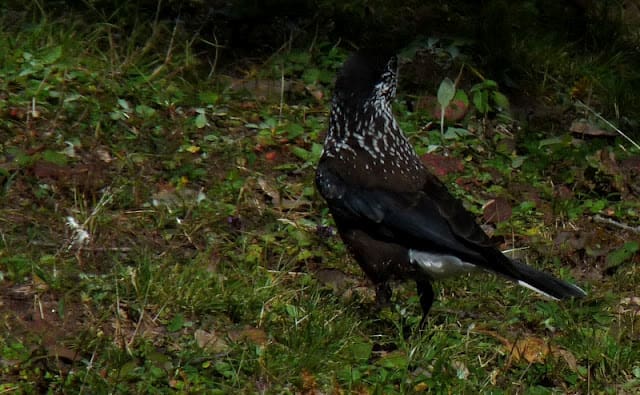 |
| The nutcracker, a gaudier cousin of the crow, boasts a voice that can startle a witch off her broom |
Black clouds shroud the now-black mountains. We battle against broad walls of heavy rain. We shelter under trees. We bend double against the wind, blowing hard and harsh. A discordant rattling note alerts us. There it is again, this time the distinctly corvid kraaak calls run rapidly together. The birds flash their tails. The white sides to tip and outer tail feathers are almost fluorescent. A caucus of nutcrackers, caught unawares by the severity of the rain, remonstrate. The rain has spoiled their chances of hacking apart the fallen cones to pick out their seeds.
The skies, now bankrupt of precipitation clear to a warm, late afternoon glow. The strains of a human voice, ringing clear and true from the forest edges, captures our ears. A young shepherd-girl pours her heart out in a ribbon of song. We are mesmerised. But she halts, inhibited by a show of embarrassment. And she breaks our calloused hearts.
We hesitate to continue – a swathe of forest has been cut to access the rush of a torrent that transects the village of Kanol. Though logs are laid across at intervals, Sunita and I cast our eyes about for easier ways of approach. Soaked to the bone, we patiently await the chowkidar of the Forest Rest House who never arrives. A perky youngster shepherds us to alternate accommodation. Not only does he house us, he also teaches us a life skill. Without a break in his step also this waif of a boy runs downhill and across the precarious logs in a leap of faith. Nothing that he does arises out of insecurity and distrust. Operating out of a mentality that is fearful is opposed to living. Yet another lesson learned.
That evening, Sahastra distributes the photographs that he had taken five years ago of the village children. Each is a snapshot of great beauty. Sahastra’s sensitivity is reflected in each. The girls are truly shy. What a treat for them.
By Jennifer Nandi
Photos by Bijoy Venugopal and Sandeep Somasekharan
Previously in ‘Odyssey to Bedni Bugyal’
Part 1 | Part 2 | Part 3 | Part 4 | Part 5 | Part 6 | Part 7 | Part 8
Next: On hobbled knee across the Nandakini

